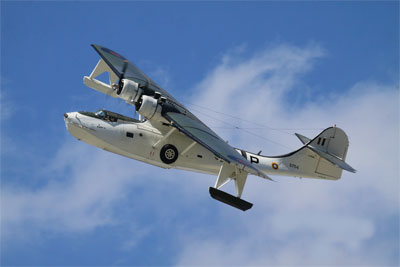
Features
Operations
A LOOK BACK: Continuing to make waves
The twin-engined Consolidated Catalina flying boat has made a splash on the world stage for seven-plus decades – and it’s still going strong.
September 26, 2011 By Raymond Canon
The twin-engined Consolidated Catalina flying boat has made a splash on the world stage for seven-plus decades – and it’s still going strong.
 |
|
| The inhabitants of Canso, N.S., must have felt flattered to see their name attached to such a versatile aircraft.
|
With Canada’s vast number of lakes and open water, the Consolidated Catalina quickly became a commercial success following its launch in the early 1930s. But this versatile aircraft really came into its own when military flying boats became popular during World War II.
When the War began, the British focused their attention on the development of another flying boat, the Short Sunderland four-engined aircraft. This flying boat patrol bomber was introduced in 1938 and developed for the Royal Air Force by the Short Brothers. The U.S., meanwhile, was determined to employ a smaller aircraft with considerable range for ocean flights – and the twin-engined Consolidated Catalina fit the bill.
While the Americans were not involved in as many international conflicts as the British during the latter stages of the 1930s, the U.S. Air Force needed an amphibian to cover wide stretches of the Pacific, where the U.S. had bases – specifically Hawaii, Midway, Guam and the Wake Islands. The Catalina made its first flight in this region in 1933. At approximately the same time, the Canadian government decided to replace its few and aging Supermarine Stranraers with the Catalina.
Three Canadian aircraft factories produced the Canso as it was called in this country – Boeing Aircraft of Canada, Canadian Vickers and Canadair. Before production was phased out, some 800 had been built here, an impressive number for any kind of aircraft but especially for an amphibian. In retrospect, the inhabitants of Canso, N.S., must have felt flattered to see their name attached to such a versatile aircraft.
The military version of the Canso frequently flew with an armament of five machine guns – one in a turret in the nose and two each in turrets on each side of the mid-fusilage. It was these two turrets that gave the aircraft its unique appearance. The same turrets could also be used as lookouts when the aircraft was on patrol.
The Canadian government opted to produce the PBY-5A version of the Catalina – a true amphibian that operated on both land and water. During the war years, Canadian pilot Flight Lieut. David Hornell made the most of his Canso, earning a Victoria Cross for attacking and destroying a U-boat (U-1224) in 1944. Unfortunately, the plane was so badly damaged that Hornell and his crew spent 20 hours in a dingy before being rescued. Even at that, he died shortly afterwards.
Postwar success
Unlike many military aircraft, the Canso’s career did not come to a close when the War ended in 1945. Both the military and the private sector continued using the aircraft in a variety of roles. Buffalo Airways’ Curtis Dyson thinks highly of the versatile aircraft. The Yellowknife, N.W.T.-based company has carried out waterbombing missions since the mid-1990s on aircraft it purchased from the Newfoundand and Saskatchewan governments; one of which was recently sold to a buyer in British Columbia who plans to convert it for passenger service.
Dyson says the Canso presents no major problems, although it can, he believes, be a bit heavy on the controls.
Whether it’s used for waterbombing missions, military uses, or passenger service, one thing is clear – the Canso, like the DC-3, certainly has longevity built into it.
| Quick facts… about the Canso PBY-5A Role: Flying boat Manufacturer: Consolidated Aircraft First flight: 1933 Introduced: 1936 Primary users: U.S. Navy, U.S. Armed Forces, Royal Air Force, Royal Canadian Air Force Number built: 4,051 (estimated) Cruise speed: 187 km/h (116 mph) Top speed: 286.5 km/h (178 mph) Engines: 2 x Pratt & Whitney R-1830-92 Twin Wasp – 1,200 hp each Empty weight: 9,464 kg (20,864 lbs.) Height: 19.51 m (63 ft., 11 in.) Height: 6.09 m (20 ft.) Crew: Up to 8 Wingspan: 30.9 m (101 ft. 8 in.) Empty weight: 9,464 kg (20,864 lbs.) Armament, military version: One machine gun forward, two machine guns in each of two mid-turrets |